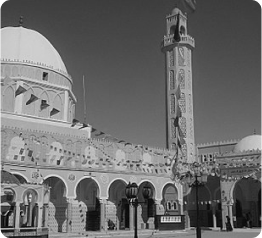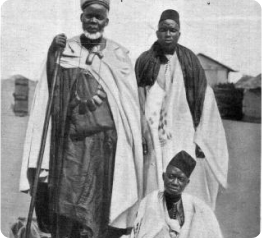Muhammad al-Hafiz al-Misri al-Tijani
By Fakhruddin Owaisi
Our master, the shaykh, the gnostic of God, the Sayyid, Muhammad al-Hafiz al-Misri al-Tijani, was one of the greatest scholars of Prophetic traditions (hadith) of Egypt in the twentieth century, as well as a renowned Friend of Allah.
Al-Sayyid Muhammad al-Hafiz bin ‘Abdul Latif bin Salim was born in the district of Munufiyya in Egypt in the year 1315 (c. 1897) to a family connected to the noble Ahl al-Bayt (household of the Prophet). After studying the religious sciences in Cairo, Shaykh al-Hafiz traveled abroad to Syria, Tunisia, Sudan, Algeria and Morocco in the pursuit of sacred knowledge. During these blessed journeys, he gained precious diplomas (ijazahs) from some of the greatest scholars of the time from the East and the West of the Islamic world, such as Shaykh Badruddin al-Hasani of Syria, Sharif ‘Abdul Hayy al-Kattani and Sidi Ahmad Sukayrij of Morocco, and Shaykh Alfa Hashim of Medina and Shaykh ‘Abdul Baqi al-Ansari of Mecca.
After his period of learning, Sayyidina Muhammad al-Hafiz totally dedicated himself to the teaching of Hadith. He taught the entire multi-volume Sahih al-Bukhari more than 40 times in Egypt, and many other books of Hadith as well. It is said that he used to know them by heart. It is narrated that when he went to Fez, Morocco, to visit the blessed tomb of Shaykh Ahmad Tijani, he was asked by the shaykhs in Fez to teach them Imam al-Nawawi’s famous “Forty Hadith” collection, which he did from memory.
He authored many great works on Hadith, Qur’anic exegesis (tafsir), history and Sufism (tasawwuf), and made tahqiq (verification) of many original gems in the field of Hadith, which were part of his private library. This library was one of the best collections of manuscripts in Egypt. To achieve this, Shaykh al-Hafiz had copied and collected manuscripts from ancient libraries in Mecca, Medina, Jerusalem, Damascus, Cairo, Fez, Tunis, Sudan, and other centers of Islamic learning that he had visited. Shaykh Dr. ‘Abdul Halim Mahmud, the Rector of al-Azhar, wrote in Sidi al-Hafiz’s obituary, “the Imam al-muhaddithin (leading hadith scholar) has died.”
Shaykh al-Hafiz also took part in the Jihad against the English in Egypt in the early 1900’s, and even Imam Hassan al-Banna, founder of the Muslim Brotherhood, used to seek his advice. In 1951, Shaykh al-Hafiz began editing a magazine dedicated to promulgating traditional Islam, called Tariq al-Haqq (“The Path of Truth”), which was widely read throughout Egypt. He also debated and defeated the Orientalists in Cairo during his time. His renown as a scholar even reached Western literary circles, and his important biography of al-Hajj Umar Futi Tal was translated into French by the Canadian scholar Fernand Dumond in 1983.
Exceeding all of this by way of distinction, however, was the fact Shaykh Muhammad al-Hafiz used to meet the Prophet Muhammad in a state of wakefulness. This was clear indication of his high spiritual station (maqam) in sainthood (wilaya).
He was originally involved in the honorable Khalwati, Naqshbandi, and Shadhili tariqahs, then left all of them to take the Way of Shaykh Ahmad Tijani at the hand of the Mauritanian Shaykh, Sidi Ahmad al- ‘Alawi al-Shinqiti.
Numerous people from all walks of life took the Tijani Spiritual Path from Shaykh al-Hafiz and attained great spiritual heights. He was as famous as a Spiritual Master par excellence as he was a hadith scholar of the age, a combination extremely rare in modern times. His Tijani Zawiyah in Cairo was and remains a great center of spiritual refreshment for those who live in or visit Cairo. His books on tasawwuf and tariqa are considered gems of spiritual knowledge.
Sayyid Muhammad bin ‘Alawi al-Maliki of Mecca was a very keen student of Shaykh Muhammad al-Hafiz in Hadith and tasawwuf when he was studying at the Azhar. He would fondly remember the “blessed gatherings” of Shaykh al-Hafiz, and always referred to him as “a great Wali of Allah”, and would often mention some of his miracles (karamat). In fact, the Sayyid always mentioned him in the forefront of the list of his teachers in all his ijazahs.
Shaykh Muhammad al-Hafiz was in close correspondence with most of the leading Tijani authorities of his time, including Shaykh Ibrahim Niasse. Shaykh Ibrahim had the occasion to visit the zawiya of Shaykh al-Hafiz during an official state visit to Egypt in 1961. In the presence of the Tijani notables of Egypt, Shaykh Ibrahim referred to Shaykh al-Hafiz as “a man who is without doubt an inheritor (khalifa) of the Shaykh Sidi Ahmad Tijani, whose description matches that of the Shaykh as I myself know him to be.” In other words, whoever has seen the face of Shaykh al-Hafiz has seen the face of Sidi Ahmad al-Tijani; a rare compliment since the Prophet himself assured Shaykh Ahmad Tijani that whoever saw the Shaykh’s face would die in a state of good faith.
Shaykh al-Hafiz al-Tijani passed away in 1398 (1978) in Cairo. He was succeeded by his learned son Shaykh Ahmad Muhammad al-Hafiz, who authored a detailed biography of his father. Among those who were blessed to achieve spiritual education at the hands of Shaykh Muhammad al-Hafiz was the Italian Shaykh Abd al-Samad Paolo, who has translated and commented several important Sufi works (amongst them the Kitab al-ta‘arruf of Kalabadhi and the Mahasin al-majalis of Ibn al-‘Arif) into Italian.
Shaykh Muhammad al-Hafiz was indeed a giant of the twentieth century. May Allah be pleased with him, and may we benefit from his example, steeped as he was in both the Sacred Law (Shari’a) and the Divine realities (Haqiqa), as a paradigm of true Muslim scholarship continuing into modern times.




